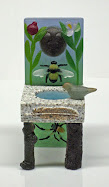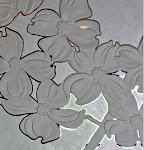We had one brief shower Thursday, one of those that happens while the sun is shining. We were moderately busy at SHARE which I suppose means President Biden's policies of helping people recover from the pandemic and reducing child poverty is having some effect. When I wasn't filling baskets, I was restocking my shelves and when I wasn't doing either of those I chatted with some of the volunteers or flattened cardboard boxes for taking to the recycling center which I do on my way home. My first day, when we went back to Thursdays last fall, towards closing, the Elders (two young men, and by young I mean 20ish, from the Mormon church here doing their volunteer work, they load the carts of food into the client's cars) had thrown all the cardboard into the dumpster. The next week I told them don't do that, I'll take it to the recycling center. It just astounds me that even now with the planet warming up, landfills full up, the planet running out of resources that people, especially young people, don't think to recycle, even the one thing that is most easily recycled, cardboard.
I managed to get another hour and a half in before yoga Thursday night. I finished all around the feather, once again building up the white or black, so no more fussiness.
Some of y'all have asked how I learned this. We are self-taught as there was no instruction in this technique when I first decided I wanted to do this type of glass casting back in 1995 (and hardly any now either though there is a wide range of glass art now being made as pate de verre but it's far different than what I do). I had seen some pictures of the work produced by the handful of 19th century French artists, all of whom were very secretive of their processes and to this day there is some uncertainty about how they actually did what they did. My favorite is Almeric Walter but Argy Rousseau's family released some (but not all) of his workbooks on his technique and we bought the book on his work that included this information. Then it was trial and error gleaning pertinent information from jewelry making and bronze casting and ceramics, buying books as they became available with any information by other artists on their own efforts and glass casting in general. We experimented with different plasters and formulas for mold making. There was already an industry for making rubber or silicon reproduction molds. We had a lot of failures but slowly, eventually our failure rate declined and we started producing a series of sculpted small bowls (2 part mold) then larger ones, then a cup form (3 part mold) and then finally now I mostly stick to the easier open face molds. I'm not that interested in pushing the boundaries anymore.
Anyway, I've written about it before so I'm going to refer you to an old post about early days and a link to my website about the technique and our process.
This is a link to the last in a series of posts I did about becoming a glass artist and it explains how we started in this technique. There's also a link to all 13 of the posts in the very first paragraph.
This is a link to the technique page on my website that shows the step by step process of making one of my little sculptures or wall pieces. Also on that page in the upper left hand corner is a link to a page with the history of this ancient form of glass casting.
Two and a half hours on Friday before lunch and all the rocks are done.
Two hours after lunch and I'm done. I decided at the last minute not to use the black sand mix as I put the color sample next to one of the big rocks in the mold and decided there wouldn't be enough definition between the two, that they would just all blend together and I spent too much damn time on those rocks to have them disappear so I chose the next darkest sand color (it will darken after it's fired). Of course last night in the middle of the night I'm kicking myself for not adding in a small percentage of black. Now it goes in the kiln.
And I am glad to be finally getting done with this series, four 10” x 10” and six small ones of various dimensions. I made all the models 4 years ago in 2017 right before Harvey and the house flooding. The six little ones and one big one got cast before the end of that year. In 2018 another of the big ones got cast, in 2019 the third big one got cast, and finally now the last one in 2021. Of course those years after Harvey I was dealing with getting the house fixed and then the pandemic and getting Pam's house set up which just took the wind out of my sails.
After this last one is cast and finished I'll post all 10 pictures.
I'll probably take the weekend off though I'll have to go over and clean up and put away all the mold filling tools and materials so that I can get out all the model making stuff and start on the models for the two angel trumpet plaques.













I was having trouble visualizing how the rocks and feather were going to look in the end, but now I'm getting it, and I like it. I'm with you -- it would be a shame to have those rocks disappear! I appreciate your comments about being self-taught, and the links to your "history" with the techniques. When I decided to start varnishing boats, I didn't know squat about how to go about it. But, with advice from others and a good bit of experience (read: mistakes) I started to figure it out.
ReplyDeleteI'll never forget those magic words when I was jobless, homeless (living with the parents again), footloose, and fancy free and didn't want to be a wage slave somewhere when I expressed my astonishment that an artistic friend was making his own way, self employed with his various skills. anyone can do it, he told me. it was like a light bulb going on in my head. it really is amazing that you can create a living out of some skill or idea if you just persevere. how do you do it, people ask. easy, I don't quit. you suck it up, get advice, self promote. not that I make a living with the cast glass but I did with the etched glass.
DeleteGood to be close to the end. I'm looking forward to this and pictures of the series.
ReplyDeleteIt must feel good to finally finish this series. I look forward to seeing all the photos together!
ReplyDeleteI don't understand why your volunteers wouldn't be recycling boxes -- which, as you said, are the most easily recyclable material. I thought young people were supposed to be super-aware of the planet and ecology?
this series was really an experiment, a departure from my usual aesthetic. most the small ones I didn't care for particularly. I think the big ones, so far, were successful in a way but I don't think they'll ever sell.
Deleteand yeah, young people. I blame religion. also, apparently they'd rather blame boomers for what ails them.
I agree with you about blaming religion. I do not think that Mormons put a lot of emphasis on environmental matters. They are looking forward to their lives after death. This life on this earth seems to be mostly a proving ground to get to that one beyond.
ReplyDeleteI would never have guessed you are self-taught. You have such mastery of the technique, including the wisdom to embrace happy mistakes when they show up to teach. I'm loving following along.
ReplyDeleteAs you may remember, I'm chair of the green committee at church. We kind of just went on hiatus last year, but now that we're back in church again (at least for now - I'm looking at you Delta!), I should probably get us started up again. It's just hard because our little piddly changes don't really mean much. But at least they mean SOMETHING.
ReplyDeleteCan't wait to see the final feather!
That was really interesting to read about how you developed the technique and it reminded me of a visit to Nancy in France - which is a really glamorous French city - where we saw some of that kind of glass work at the museum and this "cristallerie" https://www.mv-bracelet.com/cristallerie/cristal-daum-nancy/
ReplyDeleteI'm very familiar with Daum glass and their work is absolutely beautiful but it is not pate de verre (paste of glass). While they refer several times to 'paste' in the link you sent, it is dry crushed glass, frit or cullet (another word for crushed glass). Nowhere in the article does it say that the cullet is mixed with binding agent that clumps it together into a 'paste' that is then packed selectively in the mold. what they do is more properly called 'frit cast'. they pour the different colors of the dry loose cullet into the mold. after we'd been working on this process for 5 years or so, maybe longer, I don't really remember, but an upscale department store here was having a showing of Daum glass and one of their artists/craftsmen were on site to talk to people about the glass. we went an spoke with him and he confirmed that they do not make a paste of the glass and do use dry loose frit/cullet. I'm a stickler about this and the terminology because doing what I do is far more difficult and time consuming than what they do.
DeleteThanks for this clarification!
Delete